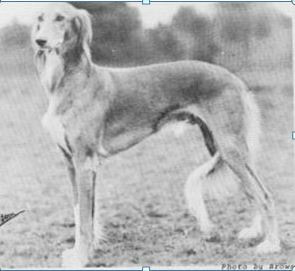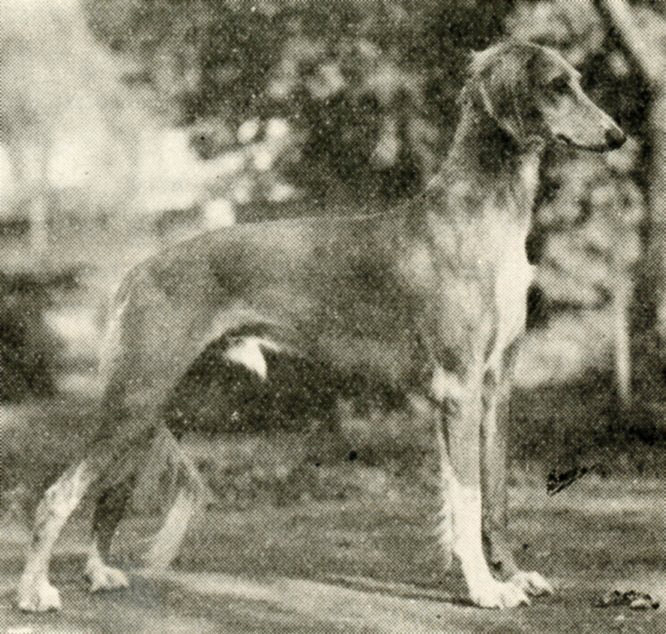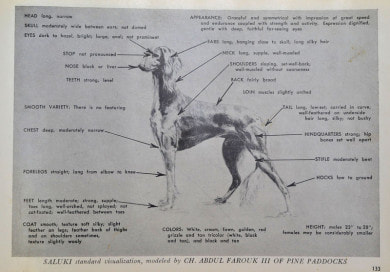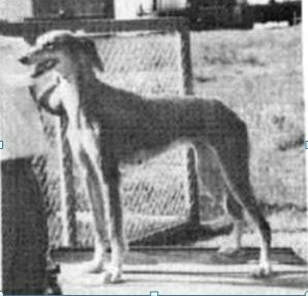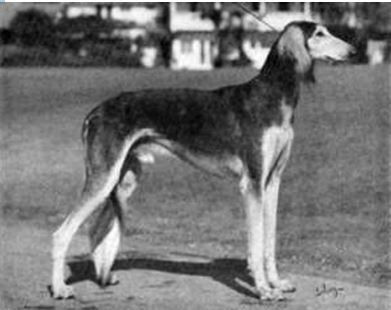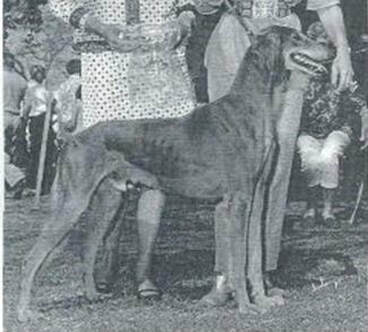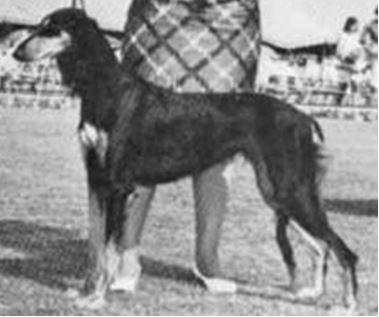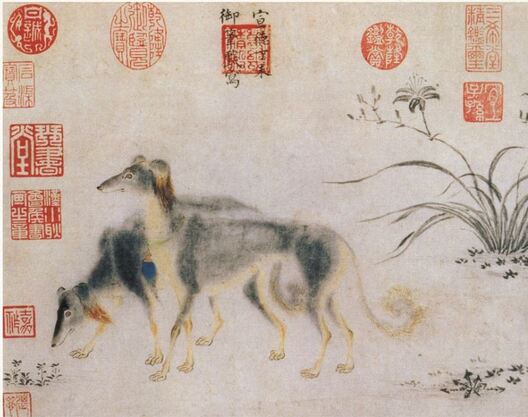 Salukis have an ancient far-flung history. They are believed to have first entered China during the Tang Dynasty (AD 619–907). Emperor Hsuan-tsung reigned from 1426–1435 and was one of the most artistically talented rulers of his time. He produced this beautiful pen and ink drawing in 1427, entitled 'Two Saluki Hounds.'
Salukis have an ancient far-flung history. They are believed to have first entered China during the Tang Dynasty (AD 619–907). Emperor Hsuan-tsung reigned from 1426–1435 and was one of the most artistically talented rulers of his time. He produced this beautiful pen and ink drawing in 1427, entitled 'Two Saluki Hounds.'
Historical Roots of the Standard
Many new judges find the saluki standard perplexingly vague. And they're not happy that no two dogs seem to look alike. But that's because the breed is a conglomeration of dogs picked from all over the Middle East, and even some areas arguably not quite in the Middle East. They were developed in different climates to hunt different prey over different terrain. The great shame would be if they DIDN'T look different! Our standard is vague to accommodate a lot of different styles. The challenge is determining when one dog is too far off the beaten path.
The other challenge is trying to determine running ability in a standing or trotting dog. The truth is internal physiology plays a more important role than what you can see in the ring, but you can at least avoid traits that seem to work against speed and stamina. In my experience those are 1) being overweight and 2) having short legs, especially short front legs. Pretty much everything else doesn't seem to matter all that much in the field.
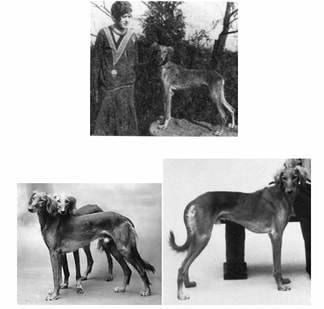
But first: Why are there so many different styles of salukis?
The saluki gene pool is pulled from the entire Middle East, and dogs in different areas were used to hunt anything from hare to gazelle to wild ass. The two most influential Saluki advocates in England had dogs that were very different.
The first strain, pre-1900, Amherstia, were from Egypt and were smaller, lighter boned, longer legged with less feathering than the salukis to come later. They were owned by Lady Amherst and are pictured to the left.
Then came General Lance, whose Sarona salukis were from colder areas of Syria, Iraq and Iran. They were stockier, hairier, and heavier boned. They are pictured below. The bottom two pictures are of Ch Sarona Kelb: Born in Damascus, imported into England in 1921. Sire of 26 litters. Largest single influence in the pedigree of virtually every Saluki.
When it came time to draw up a standard, the compromise was to make it vague enough so that both Amherstia and Sarona dogs were included. Realistically, whether because the Sarona dogs fit more with the English ideal of show dogs, or Lance was the more forceful personality, Sarona Kelb and his descendants did almost all the winning. Sarona Kelb is many times behind most salukis today.
The saluki gene pool is pulled from the entire Middle East, and dogs in different areas were used to hunt anything from hare to gazelle to wild ass. The two most influential Saluki advocates in England had dogs that were very different.
The first strain, pre-1900, Amherstia, were from Egypt and were smaller, lighter boned, longer legged with less feathering than the salukis to come later. They were owned by Lady Amherst and are pictured to the left.
Then came General Lance, whose Sarona salukis were from colder areas of Syria, Iraq and Iran. They were stockier, hairier, and heavier boned. They are pictured below. The bottom two pictures are of Ch Sarona Kelb: Born in Damascus, imported into England in 1921. Sire of 26 litters. Largest single influence in the pedigree of virtually every Saluki.
When it came time to draw up a standard, the compromise was to make it vague enough so that both Amherstia and Sarona dogs were included. Realistically, whether because the Sarona dogs fit more with the English ideal of show dogs, or Lance was the more forceful personality, Sarona Kelb and his descendants did almost all the winning. Sarona Kelb is many times behind most salukis today.
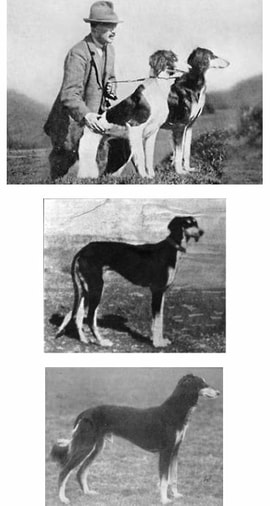
Sarona dogs are pictured on the left. Ch Sarona Kelb is the bottom two dogs, at different ages.
Here are some videos of English Salukis of the 1920s and 1930s:
1923 English Salukis: https://www.britishpathe.com/video/the-greyhound-of-the-east
1930 English Salukis: https://www.youtube.com/watch?v=YCE-rPIcq8s
1933 English Salukis: https://www.youtube.com/watch?v=yAVxxEAkarM
English salukis of today still tend to be larger boned than most American Salukis of today.
Here are some videos of English Salukis of the 1920s and 1930s:
1923 English Salukis: https://www.britishpathe.com/video/the-greyhound-of-the-east
1930 English Salukis: https://www.youtube.com/watch?v=YCE-rPIcq8s
1933 English Salukis: https://www.youtube.com/watch?v=yAVxxEAkarM
English salukis of today still tend to be larger boned than most American Salukis of today.
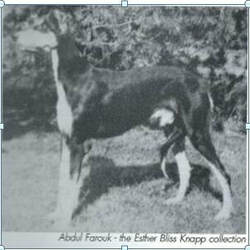
Farouk II's son, Abou FaroukIn 1945, Abdul Farouk was imported from Arabia to the USA (Ohio) and given to Esther Knapp of Pine Paddocks salukis (note cropped ears). Her dogs were based on him, and she became the President of the SCOA and the absolute authority on Salukis in the US, with the top winning salukis. His great grandson, Ch Abdul Farouk III modeled the standard for many years; his son Abhou Farouk in turn was a big winner with 12 BISs to his credit.
Eventually Mrs Knapp had to retire and became honorary lifetime president, and eventually SCOA had to let in more members, even Srinagar owners and coursing people, eventually they had to have public voting on members, and eventually they had well-publicized and attended nationals. SCOA and ASA got over their animosity and now work together. ASA is the "club of the people" and SCOA is the parent club with the power.
Many still feel the divide between Jen Araby/Srinagar ("West Coast") salukis and Eastern/Midwestern "Old American" salukis. Most of the Salukis you see winning today at group level are of Jen Araby/Srinagar descent. Most of the Salukis you see touted as good examples at SCOA seminars are not of Jen Araby/Srinagar descent.
The JA/Srinagar descendants tend to have more feathering, more side movement, more curves, more refinement compared to the others. The "Old American" bloodlines are more moderate in curves, heavier boned, less side movement and often larger overall.
Which style is correct?
BOTH! And others! Saluki breeders prize the variety of styles as being a trait of the breed. From a judging perspective, no, all your winners don't have to look alike. There can be good dogs from a variety of disparate styles. The hard part is deciding at what point is a style too deviant to be correct? And of course, that's where the arguments start because the standard IS so vague...
Some questions not addressed in the standard: *we will revisit but in brief....*
· Are some salukis improved beyond the point of preserving the breed? This would be the complaint of those against JA/Srinagar. (Oddly, when we have had visitors from the Middle East come to the National to buy dogs, they invariably try to buy the JA/Srinagar type ones! But it is true that these dogs are more exaggerated than what you would normally see in Country of Origin dogs).
· What is proper body proportion? (As a sighthound, this should be a long-legged breed. Short-legged dogs don't run fast. It can be long-legged and long-bodied, or long-legged and short-bodied---just not short-legged! This means there should be plenty of "air" beneath the dog. )
· Head planes? (Most breeders agree the planes should be nearly parallel--no down-faces or extreme Roman noses or triangular shaped profiles.) Srinagar dogs especially had a problem of down faces.
· Ear set? (not in the standard, but 99% of breeders want it high.) Again, Srinagar tended to produce a lower earset.
· Tail carriage? Tail SET should be low. Lots of disagreement about carriage---generally, if it's carried high it should not be in a tight curl and it should be because the dog is happy.
· Angulation? Moderate means neither S-shaped not straight.
· Bone? Strong enough to bring down a gazelle, light enough to be carried on the back of a horse ---and not a Clydesdale).
· Even color has become controversial---Want to start an argument? Talk about brindle salukis!
